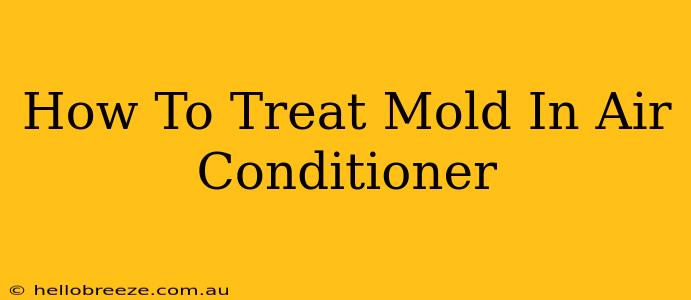Mold in your air conditioner is not just unsightly; it's a potential health hazard. This comprehensive guide will walk you through identifying, preventing, and treating mold in your AC unit, ensuring a cleaner, healthier home environment.
Identifying Mold in Your Air Conditioner
Before tackling the problem, you need to know what you're dealing with. Mold in air conditioners typically appears as:
- Fuzzy, dark patches: Look closely at the evaporator coils, air filters, and any other damp areas within the unit. Black, green, or gray fuzzy patches are a clear sign of mold growth.
- Musty odor: A persistent musty or mildew smell emanating from your AC could indicate hidden mold.
- Respiratory issues: If you or your family members experience allergy-like symptoms (coughing, sneezing, watery eyes) when the AC is running, mold could be the culprit.
Important Note: If you suspect significant mold growth, especially if you notice a large area or unusual colors, it's best to consult a professional HVAC technician. They have the expertise and equipment to handle extensive mold problems safely and effectively.
Preventing Mold Growth in Your Air Conditioner
Prevention is always better than cure. Here are some proactive steps to minimize mold growth:
1. Regular Air Filter Changes:
This is the single most effective preventative measure. Dirty filters restrict airflow, leading to increased humidity and creating ideal conditions for mold. Change your air filters every 1-3 months, or more frequently if you have pets or allergies.
2. Proper Drainage:
Ensure your AC unit's condensate drain line is clear and functioning correctly. A clogged drain can cause water to accumulate, providing a breeding ground for mold. Regularly check and clean the drain line to prevent backups.
3. Regular Cleaning:
Clean the exterior of your air conditioner unit regularly, removing dust and debris that can contribute to mold growth. Use a soft brush or cloth and mild detergent.
4. Proper Ventilation:
Ensure adequate ventilation in the rooms your AC cools. Poor ventilation can increase humidity levels, which promotes mold growth. Use exhaust fans in bathrooms and kitchens to remove moisture.
5. Professional Maintenance:
Schedule annual professional maintenance for your air conditioner. A trained technician can identify potential problems, clean internal components, and ensure proper drainage.
Treating Mold in Your Air Conditioner: A Step-by-Step Guide
For minor mold infestations, you can attempt cleaning yourself. However, always wear protective gear, including gloves, a mask, and safety glasses.
Materials You Will Need:
- Rubber gloves
- Safety glasses
- N95 respirator mask
- Mild detergent
- Soft brush or cloth
- Bleach solution (1 part bleach to 10 parts water – use with caution!)
- Spray bottle
- Vacuum cleaner with a hose attachment
Steps:
- Turn off the AC unit: Safety first! Always disconnect the power before cleaning.
- Remove the air filter: Clean or replace it as needed.
- Vacuum loose mold: Use the vacuum cleaner with a hose attachment to remove loose mold spores and debris from accessible surfaces.
- Clean with detergent: Prepare a mild detergent solution and carefully scrub affected areas with a soft brush.
- Apply bleach solution (with caution): For stubborn mold, carefully apply the bleach solution, ensuring adequate ventilation. Never mix bleach with ammonia or other cleaning agents. Let it sit for a few minutes before rinsing thoroughly with clean water.
- Dry thoroughly: Allow all components to dry completely before reassembling the unit.
- Replace the air filter: Put back the clean or new air filter.
- Turn the AC back on: Once everything is dry, you can safely restore power to the unit.
When to Call a Professional
If the mold infestation is extensive, you're uncomfortable cleaning it yourself, or you notice any signs of significant mold growth, it's crucial to contact a professional HVAC technician. They have the expertise and equipment to safely and effectively remove mold from your air conditioner.
By following these steps and prioritizing preventative measures, you can significantly reduce the risk of mold in your air conditioner, ensuring a healthier and more comfortable living environment. Remember, early detection and proactive cleaning are key to keeping your AC unit mold-free.

